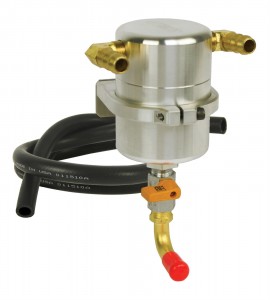How it Works: Better Performance with Moroso’s Air/Oil Separator
 Positive crankcase ventilation (PCV) systems were created for a reason.
Positive crankcase ventilation (PCV) systems were created for a reason.
These systems alleviate combustion pressure from an engine’s crankcase by using engine vacuum to suck the pressure out of the crankcase. Once the air pressure is drawn out of the crankcase, it is reintroduced into the intake charge as it enters the engine. While PCV systems play an important role in engine operation, they do create a negative side effect, particularly in high performance applications.
As PCV systems suck the pressure out of the crankcase, it also draws out a fine mist of oil which is then included in the air/fuel intake charge. Although you might not notice any performance loss in a stock engine, the excess oil included in the intake charge can lead to reduced combustion, fouled spark plugs, and less overall power output. In some cases, it can even cause harmful detonation.
To prevent these potential issues, Moroso offers an air/oil separator.
The Moroso Air/Oil Separator is plumbed into the PCV system between the crankcase and vacuum source. As pressure is drawn from the crankcase, it’s routed through the separator canister. Inside the canister, it runs through a series of baffles and steel mesh, which separates oil and moisture from the airflow. The oil drains to the bottom of the canister while the clean air continues into the intake and re-enters the engine.
Moroso offers the air/oil separators in a couple different sizes. The larger versions feature drains that allow you to easily remove any accumulated oil. The smaller separators feature a two-piece body that unscrew to drain the oil. You can choose from natural, anodized, and polished canisters, depending on which size your choose.
So exactly how much oil runs through your PCV system? And how well does the Moroso Air/Oil Separator prevent that oil from contaminating the intake charge? Watch the video below and see for yourself:





So what is the emission disadvantage -reasoning for being illegal to sell these “oil separators” in California? What does it exactly do to the engine’s emission? I would think it would benefit the environment more so than not.
The output can go through small oil catch k&n filter into air. So you don’t have any oil any oil into your intake. I think they are scared that you do that. Or maybe dispose the oil from the catch tank into the drain